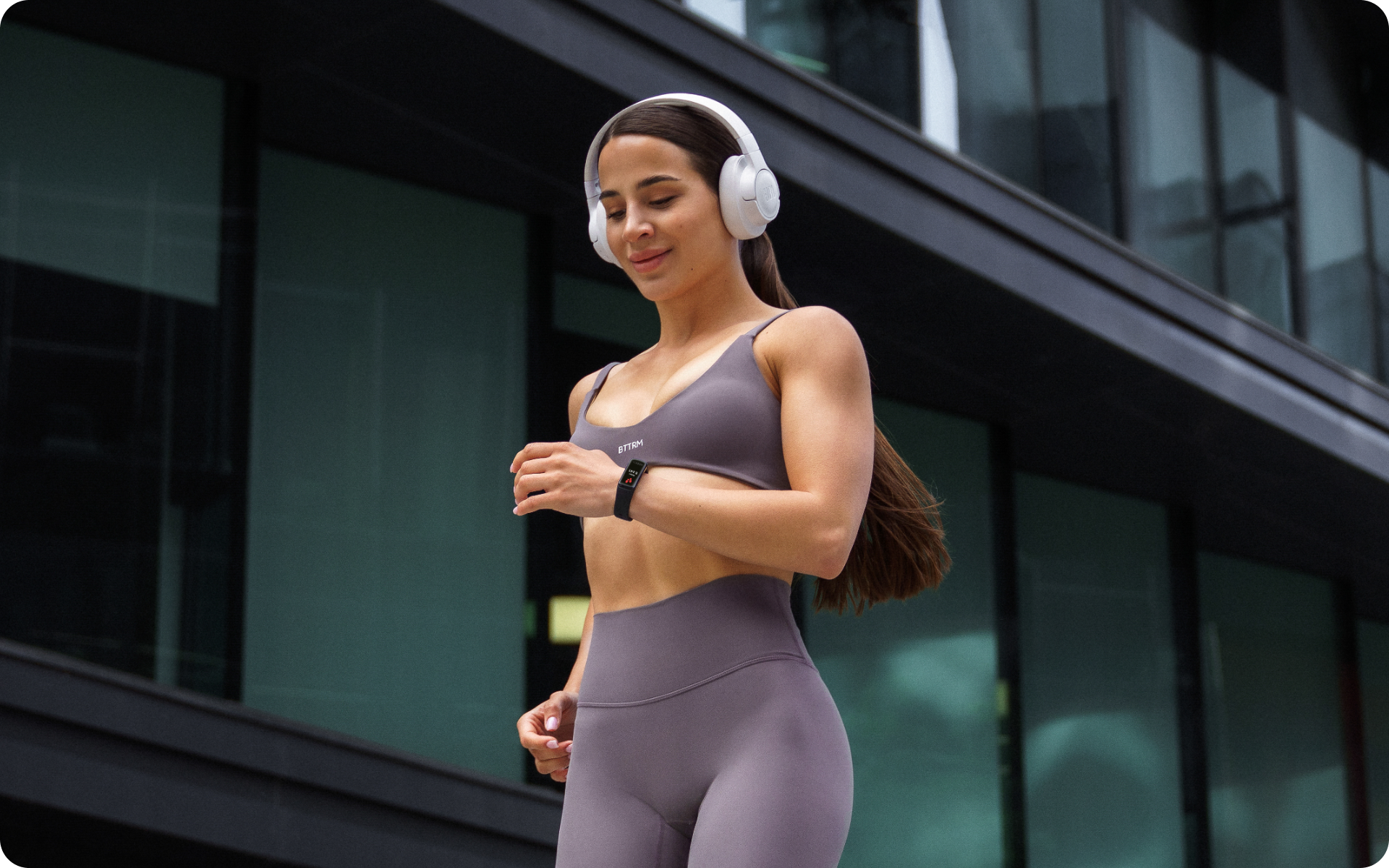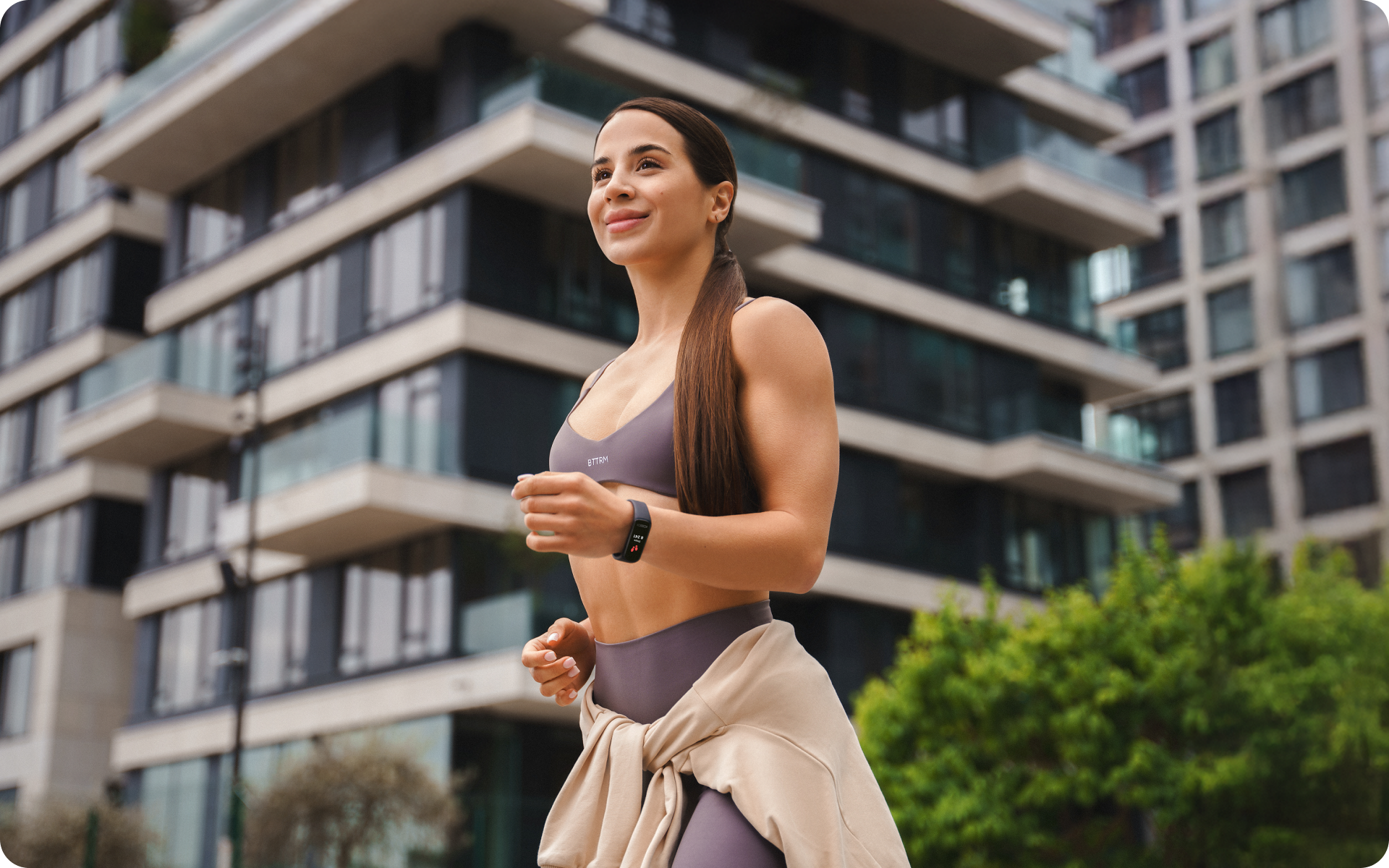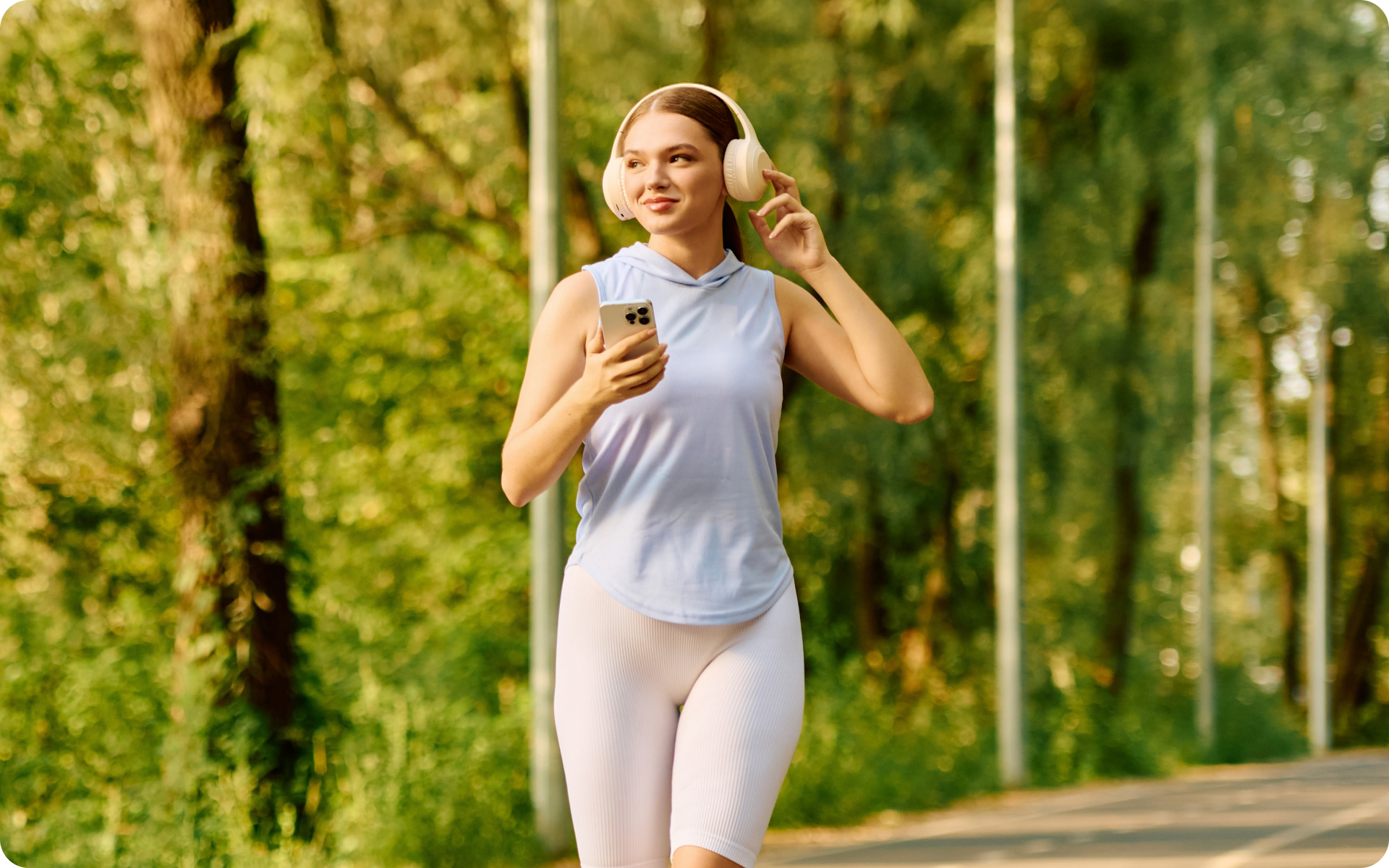A 5-minute walking workout is a short but effective way to increase your energy, improve circulation, and build a consistent routine. Whether you’re new to exercise or looking for a way to incorporate more activity into a busy workday, a 5-minute workout routine can help you achieve your goals.
What Is a 5-Minute Walking Workout?
A 5-minute walking workout is a short exercise that focuses on brisk walking and other walking-based movements to help increase your heart rate. It can include various walking styles, such as power walking, side steps, and Nordic walking. Adding light hand or ankle weights can help increase the intensity, which can boost your heart rate and calorie burn even further (1).
These workouts are ideal for early mornings and midday when increased circulation can provide an energy boost.
Can a 5-Minute Workout Be Effective?
A 5-minute workout can be effective for getting your blood flowing, which helps improve your mood and increase focus. While it may not replace a comprehensive workout plan, it can help you establish a consistent routine that offers significant health benefits over time (2).
If you spend long periods sitting each day, taking 5 minutes every hour to stand and walk is essential for your long-term health.
When it comes to weight loss, progress is made by inches, not miles, so it’s much harder to track and a lot easier to give up. The BetterMe: Health Coaching app is your personal trainer, nutritionist, and support system all in one. Start using our app to stay on track and hold yourself accountable!
Are 5-Minute Walks Effective?
A 5-minute walk can help maintain mobility and increase blood flow, particularly if you spend a lot of time sitting. Walking after eating can also help regulate blood sugar levels.
You can enhance the effectiveness of your short walks by varying your pace frequently, selecting more challenging terrain, and incorporating walking exercises such as heel-to-toe taps, toe raises, and side steps (3).
Read more: Recommended Steps Per Day by Age: How Many Steps You Should Take Daily?
Does a 5-Minute Walk Count as Exercise?
Any movement counts as exercise, particularly if it helps elevate your heart rate or makes you feel energized. While it may not be all you need for cardiovascular fitness, walking consistently can contribute to your overall activity, help keep you mobile, and support a weight loss program (4).
How Many Calories Do You Burn on a 5-Minute Walk?
The number of calories you burn during any exercise, including a 5-minute walk, depends on several factors, such as your age, weight, sex, and the intensity of the activity. On average, you can expect to burn 15-25 calories during a brisk 5-minute walking workout. You’ll burn a few more if you incorporate hills or hand weights. You can also increase the number of calories you burn by taking several walks per day (5).
How Long Do You Need to Walk to Burn 500 Calories?
If your goal is to burn 500 calories per day, you’ll need to commit to a 45-90-minute walk, depending on your pace, weight, and terrain. For example, a 160-pound person who walks at a brisk pace of 4 miles per hour for 90 minutes can expect to burn approximately 500 calories. Someone heavier will burn even more calories when they perform the same workout.
Taking multiple short 5-minute walks can add up, burning calories, increasing your metabolism, and building endurance.
5-Minute Walking Workout for Beginners
- Minute 1 – Walk at a slow, comfortable pace, focusing on your posture.
- Minute 2 – Increase the pace slightly to establish a steady rhythm, and start swinging your arms to loosen up and increase your heart rate.
- Minute 3 – Stay in one spot and march in place. Aim to bring your knees up high and tap them with the opposite hand.
- Minute 4 – Step side to side to build lateral strength and endurance. Three steps to the right followed by three steps to the left, then repeat.
- Minute 5 – Return to a slow, relaxed walk to cool down.
Types of Walking Styles
- Casual Waking
Casual walking is essentially everyday walking at a comfortable, natural pace. It’s beneficial for overall health, but it won’t significantly increase your heart rate (6).
- Power Walking
Power walking is faster than casual walking and can help increase your heart rate, which makes it a great addition to a weight loss program. Bending your arms at 90 degrees and swinging them as you walk can help increase the intensity while also providing an upper-body workout (7).
- Hiking
Hiking is walking on natural terrain, including trails and paths through woods and other rural areas. These walks are typically long and may involve elevation changes and rough terrain. Depending on the trail you choose, hiking can be light or intense.
- Trekking
Trekking is extreme hiking, covering longer distances over more varied and challenging terrain. Trekking can take several days and can lead to quite remote locations.
- Nordic Walking
Nordic walking is a style of walking that utilizes specially designed poles that resemble ski poles to provide a full-body workout. It originated in Finland to help cross-country skiers practice during the off-season, but it has also become quite popular among non-skiers (8).
- Race Walking
Race walking is a competitive sport with specific rules that govern the walking technique. For example, one foot must always be in contact with the ground, and the front leg must straighten with each step.
BetterMe: Health Coaching app helps you achieve your body goals with ease and efficiency by helping to choose proper meal plans and effective workouts. Start using our app and you will see good results in a short time.
- Mindful Walking
Mindful walking is a slower-paced walk that is focused on breathing, body awareness, and the surrounding environment. Practitioners often do it barefoot in a quiet area to relieve stress.
- Urban Walking
Urban walking can be either casual or power walking in a city. Flatter ground can be easier to walk on, which can allow you to maintain consistent workouts. You can also incrementally make your workout more difficult by adding trips around the block.
- Treadmill Walking
Treadmill walking is ideal for days with bad weather and makes year-round workouts possible. It allows you to work out at a controlled pace and many machines also enable you to adjust the incline dynamically. The treadmill will also keep track of your heart rate and the distance you walk.
- Minimalist Walking
Minimalist walking focuses on strengthening your feet and improving your natural gait. You do this walking without shoes, so you’ll need to ease into it carefully to avoid injury.
Read more: How Long Does It Take To Lose 45 Pounds By Walking?
Walking Exercises for Seniors
- Walk + Arm Swings
Swinging your arms gently while walking can help increase circulation and engage your upper body. Holding light hand weights as you’re able can help increase the intensity.
- Interval Walking
Interval walking involves alternating between a normal pace and a brisk walk to help improve endurance and cardiovascular health without making the workout too difficult.
- Chair-Assisted Walking
Chair-assisted walking involves using the back of a sturdy chair or a walker to maintain balance while taking a few small, deliberate steps. It’s perfect for seniors who are struggling with balance and mobility (9).
- Step-Ups
Stepping up onto a low curb or step and then stepping back down can help build strength in your legs, which can improve general mobility. If balance is an issue, use a handrail or the wall for support (10).
- Walking Heel-to-Toe
Walking heel-to-toe in a straight line is great for improving balance and coordination. It also requires mindfulness and concentration. If you need support to get started, a wall or rail can help.
Micro-workouts are an excellent way to stay active, particularly if you have a busy lifestyle that involves a lot of sitting. A 2-5-minute workout can be enough to get your blood flowing, especially with intense movements, such as the burpee. However, a workout this short is not ultimately going to drastically improve your fitness and you’ll need to incorporate other forms of exercise if you’re hoping to get in shape. The 5-minute rule for working out is a motivational technique that’s particularly useful for individuals who struggle to motivate themselves to exercise. The rule requires you to spend just five minutes exercising before you quit for the day. Research has shown that most people continue with their full workout after the time is up. If not, you’ll at least get some exercise for the day (11). Walking at a brisk pace for approximately 20 minutes should be sufficient to burn around 100 calories. If you add hills or weights, you can do it in even less time. A 5-minute walk will typically cover about ¼ mile if you walk at a moderate pace. While it isn’t a long walk, it’s far enough to wake up your muscles, clear your mind, and increase your heart rate.Frequently Asked Questions
How short can an effective workout be?
What is the 5-minute rule for working out?
How long a walk will burn 100 calories?
Is a 5-minute walk far?
The Bottom Line
A 5-minute walking workout session may seem short, but it can have a lasting impact on your health, energy levels, and mood. The quick bursts of energy can help increase circulation and burn calories, laying a foundation for a more active lifestyle.
DISCLAIMER:
This article is intended for general informational purposes only and does not serve to address individual circumstances. It is not a substitute for professional advice or help and should not be relied on for making any kind of decision-making. Any action taken as a direct or indirect result of the information in this article is entirely at your own risk and is your sole responsibility.
BetterMe, its content staff, and its medical advisors accept no responsibility for inaccuracies, errors, misstatements, inconsistencies, or omissions and specifically disclaim any liability, loss or risk, personal, professional or otherwise, which may be incurred as a consequence, directly or indirectly, of the use and/or application of any content.
You should always seek the advice of your physician or other qualified health provider with any questions you may have regarding a medical condition or your specific situation. Never disregard professional medical advice or delay seeking it because of BetterMe content. If you suspect or think you may have a medical emergency, call your doctor.
SOURCES:
- Benefits of Walking (2023, health.clevelandclinic.org)
- Effect of interval exercise versus continuous exercise on excess post-exercise oxygen consumption during energy-homogenized exercise on a cycle ergometer – PMC (2019, pmc.ncbi.nlm.nih.gov)
- Sitting all day can be deadly. 5-minute exercise breaks can reduce health risks : Shots – Health News : NPR (2023, npr.org)
- Is walking good exercise? 4 top questions answered | MD Anderson Cancer Center (2024, mdanderson.org)
- Calories Burned Walking Calculator (2025, caloriesburnedhq.com)
- Walking – the first steps in cardiovascular disease prevention – PMC (2011, pmc.ncbi.nlm.nih.gov)
- Effect of walking exercise on abdominal fat, insulin resistance and serum cytokines in obese women (2014, e-pan.org)
- 5 Reasons To Try Nordic Walking (2022, health.clevelandclinic.org)
- How to Join a Walking Club for Seniors (2025, seniorsinfo.org)
- Step Ups: Benefits, Muscles Worked, and More – Inspire US (2023, inspireusafoundation.org)
- End Procrastination with the 5-Minute Rule | Using the 5 Minute Rule — Cognitive Behavioral Therapy Los Angeles (2023, cogbtherapy.com)











